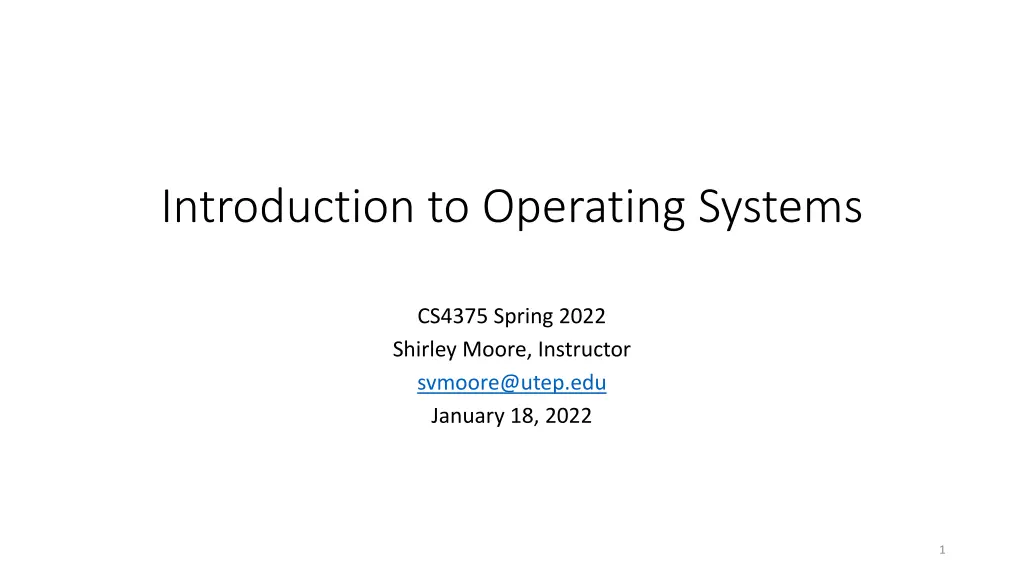
Introduction to Operating Systems CS4375 Spring 2022
Explore the fundamentals of operating systems in the course taught by Shirley Moore. Dive into course logistics, schedule, and the importance of understanding OS concepts. Attend in-person for optimal learning and engage in hands-on exercises to grasp the key aspects of operating systems effectively.
Download Presentation

Please find below an Image/Link to download the presentation.
The content on the website is provided AS IS for your information and personal use only. It may not be sold, licensed, or shared on other websites without obtaining consent from the author. If you encounter any issues during the download, it is possible that the publisher has removed the file from their server.
You are allowed to download the files provided on this website for personal or commercial use, subject to the condition that they are used lawfully. All files are the property of their respective owners.
The content on the website is provided AS IS for your information and personal use only. It may not be sold, licensed, or shared on other websites without obtaining consent from the author.
E N D
Presentation Transcript
Introduction to Operating Systems CS4375 Spring 2022 Shirley Moore, Instructor svmoore@utep.edu January 18, 2022 1
Schedule for Todays Class Course logistics, syllabus, and learning outcomes (15 min) Course motivation (10 min) Operating system concepts (20 min) Preparation for lab assignments (15 min) Q&A (20 min) 2
Course Logistics Course webpage with syllabus, learning outcomes, lecture schedule, and assignments svmoore.pbworks.com Microsoft Teams for assignments and interaction Blackboard for quizzes, grades, and announcements 3
Class Attendance In-person attendance is strongly recommended. A Teams call will be started at the beginning of each class to allow remote participation for those who are unable to attend in person. Lectures will be recorded and uploaded to Teams. Attending remotely or viewing recorded lectures is not a good substitute for in-person attendance. You won t be able to see what I write on the board. It will be harder to participate in group work and hands-on exercises. Growing evidence that students who attend classes remotely don t do as well. 4
Course Motivation Why should you take this course? The operating system is a key part of most computer systems. It s the magic that provides abstractions for CPUs, devices, address space, and network communication. Understand tradeoffs between performance, functionality, security, and reliability. Understand the environment in which your application executes. Troubleshoot problems that come from outside your application, since it interacts with the hardware through the OS. Understand concurrency and concurrency bugs. 5
Approaches to Learning OS Hear and forget Paper/lecture approach: read/hear about it, do exercises on paper See and remember Exercises using existing OS or simulator (Linux, Python simulation) https://github.com/remzi-arpacidusseau/ostep-code https://github.com/remzi-arpacidusseau/ostep-homework.git Do and understand (design and write OS code!) Modify/extend real OS (teaching OS tractable for a class xv6 for RISC-V) https://github.com/mit-pdos/xv6-riscv.git Design/create your own OS and become an expert Beyond scope of this class 6
What This Class is About An operating system (OS) is the systems software that interfaces application programs with the underlying hardware. Applications make requests for services through a defined API. The OS manages and interfaces to underlying hardware (e.g., processors, memory, storage devices, network interfaces) so that applications don t need to know about hardware details. The OS launches and manages every application, including multiple processes or threads. 7
Types of Operating Systems General-purpose operating system Can run multiple types of applications on a broad range of hardware Examples: Windows, MacOS, Unix, Linux Mobile operating system Aims to achieve efficient performance and resource usage and fast response time Scaled back in size and complexity Examples: Apple iOS, Google Android Embedded operating system Stripped down and dedicated Used with special purposes devices -- e.g., ATMs, IoT devices, medical devices Usually provided on a chip that is incorporated into the device Example: Embedded Linux Real-time operating system Must respond quickly and predictably under time constraints Example application: industrial control system Examples: FreeRTOS, VxWorks 8
Key Operating System Concepts Abstraction/virtualization The OS takes a physical resource (e.g., processor, memory, disk) and transforms it into a more general, powerful, easy-to-use abstract/virtual form. Code examples: cpu.c, mem.c Concurrency When multiple sequences of operations can be run simultaneously Execution of different sequences may be interleaved or in parallel Examples of concurrency problems: race conditions, deadlock, starvation Code example: thread.c Persistence Store data reliably File systems Code example: io.c Security Isolation/protection, access control, cryptography 9
Preparation for Lab Do the steps below from https://pdos.csail.mit.edu/6.828/2021/tools.html 1. Running a Linux VM or Installing on Windows 2. Install Ubuntu 20.04 3. Debian or Ubuntu 4. git clone git clone git://g.csail.mit.edu/xv6-labs-2021 5. Testing your Installation Follow instruction for Boot xv6 at https://pdos.csail.mit.edu/6.828/2021/labs/util.html 10
Booting xv6 demo $ cd xv6-labs-2021 $ git checkout util $ make qemu $ ls $ Ctrl-p $ Ctrl-a x 11
